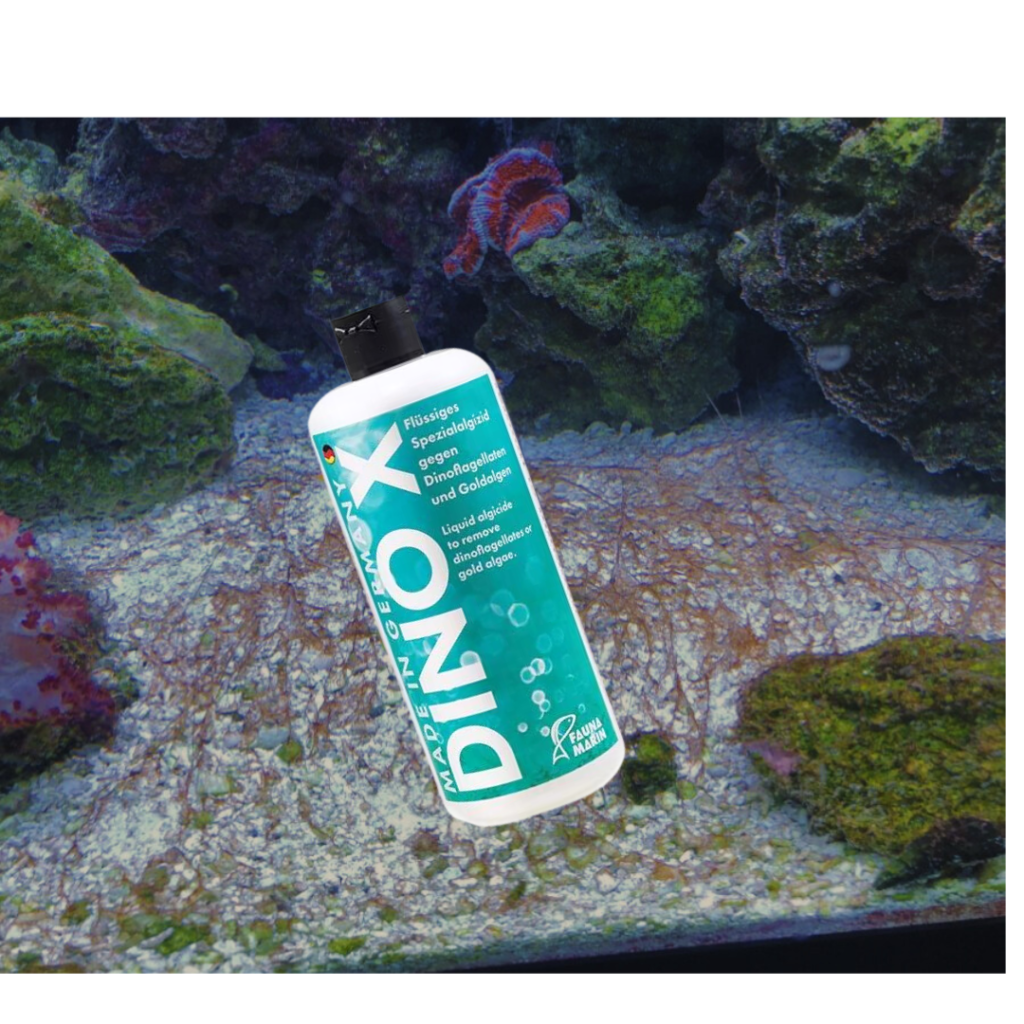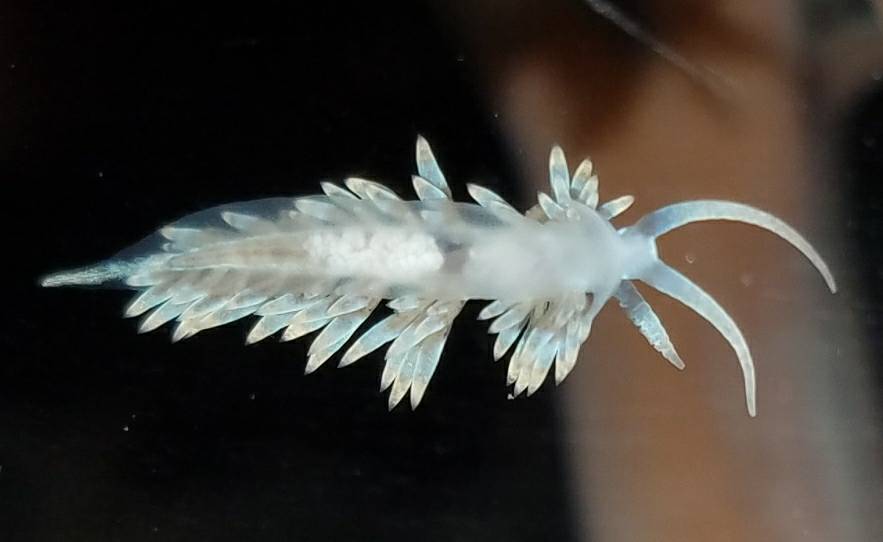In the captivating world of reef keeping, maintaining a balanced, vibrant, and healthy aquarium can be an intricate dance. Especially when stubborn dinoflagellate outbreaks decide to crash the party. Dino X has emerged as a potent and promising solution, championed by many for its ability to combat algae and dinoflagellates. But how effective is it, really? And is it safe for your corals and fish? In the blog post I will give my Dino X review and answer if it really works.
What is Dino X?
Dino X is a specially formulated product designed to tackle a broad range of algae types. It can help you combat hair algae, bubble algae, bryopsis, and the troublesome dinoflagellates. Due to its non-algae-specific action, it holds the potential to be a flexible weapon in the arsenal of a reef hobbyist.
This versatility makes it a sought-after solution, particularly for those reef keepers who face persistent challenges with a variety of algae types. It’s essentially a multi-purpose algaecide, intended to bring back the balance to your tank that harmful algae outbreaks disrupt.
Related: Saltwater Algae Types: Identification, Causes, and Management
How Does Dino X Work?
Dino X operates by targeting and inhibiting the photosynthesis process of Zooanthellae algae. It’s worth noting that photosynthesis is an essential life process for these algae, as it provides the energy necessary for their growth and reproduction.
When Dino X is introduced to your aquarium, it interferes with this vital process, disrupting the algae’s ability to generate energy. In simple terms, Dino X starves the algae and dinoflagellates by depriving them of their sustenance, which eventually leads to their decline and removal. It’s a rather straightforward, yet effective, mechanism.
How to Use Dino X
The instructions for using Dino X are explicit and should be adhered to strictly to prevent overdosing. The recommended dosage is 5 ml of Dino X for every 100 L (26 gal) of aquarium water. It’s crucial to accurately calculate the volume of your tank water for precise dosing.
For severe infestations, the dosage can be cautiously increased up to 6ml Dino X per 100 L (26 gal). Repeat this dosage every two days until you observe that the algae has been completely eliminated.
Refrain from performing water changes during the treatment period and resume your water change schedule one week after the last Dino X dose.
Diatoms or Dinos: How to identify the Difference (From Expert Reefers)
Is Dino X Safe?
“Dino X is reef-safe” is a phrase often echoed by the manufacturer, which suggests that it shouldn’t have adverse effects on corals or invertebrates when used as directed. However, the term ‘reef-safe’ is not synonymous with foolproof. Your reef tank is a complex, dynamic ecosystem where several variables contribute to the well-being of its inhabitants.
Factors such as the specific species present, their individual resilience, and any existing stressors can affect the impact of Dino X on your marine life. It’s crucial to bear this in mind when considering Dino X as a solution for your tank.
How To Get Rid of Diatoms In Your Reef Tank (Guaranteed Fix)
While I have only experienced positive results with no observable harm to my fish and corals, others users have reported fish and coral loss following treatment with Dino X. This range of experiences underscores the importance of careful application and close observation during and after treatment.
But to answer the question of Is Dino X Safe? I would say yes, when used correctly and a close eye is kept on your fish and corals dino x is a great solution to ridding your tank of Dinoflagellates.
My Review and experience using Dino x
When my ref tank went through a Dino outbreak I felt defeated as I just simply could not get rid of them. I did multiple water changes and blackouts, only for them to return with a vengeance.
After doing through research I stumbled upon Dino X and decided to give it a try. Closely following the dosing instructions, changing my filters and implementing a black out, I noticed my Dino outbreak started to subside. I think the combination of a blackout as well as dosing Dino X is the best way to get rid of Dinos.
Before using the Dino x I was worried that my corals and fish would be unhappy, however I did not notice any of the above.
Conclusion
Navigating the dynamic, delicate balance of reef tank maintenance often calls for the assistance of products like Dino X. It’s important to remember, however, that while effective in many cases, Dino X is a powerful solution that demands respect. Using Dino x requires careful dosing, observation, and an understanding of its impact on your specific tank environment.
When wielded correctly, Dino X may help you win the battle against algae and dinoflagellates, restoring harmony to your reef tank. However, always ensure you prioritize the well-being of your reef’s inhabitants, using such treatments as Dino X judiciously. Your reef tank’s balance and vitality hinge on your informed decisions and attentive care.
Related: Diatoms or Dinos: How to identify the Difference (From Expert Reefers)
Tips:
- Accurate Dosage: Administer 5 ml Dino X per 100 L (26 gal) of aquarium water. For heavy infestations, up to 6ml can be dosed.
- Timing: Dose Dino X in the evening or 1 hour AFTER the main lighting has shut off.
- Repeat Dosages: Dosage should be repeated every two days until algae is completely eliminated.
- No Water Changes: Do not perform water changes during the treatment period. Resume water change schedule after 1 week of the last Dino X dose.
- Limit Additives: Avoid dosing any trace elements, mineral salts, amino acids, SPS food, or Balling Light Trace B Elements during treatment.
- Limit Absorbing Media: Discontinue the use of absorbing media such as GFO and PO4 removers during treatment.
- Monitor Inhabitants: Keep a close watch on your tank’s inhabitants. While Dino X is generally safe for inverts and fish, any signs of distress should be promptly addressed.
- Limit Lighting: Keep the main lighting phase to no longer than six hours daily during the treatment period.
If you’d like to try out Dino x Click Here



